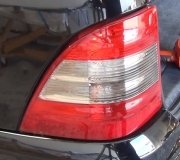Are you using a standard old-fashioned, and ultra-reliable thermal flasher or a newer one made for LED lights? If it's a thermal flasher, those have a heating element and no polarity. Its two wires can be connected either way, but it needs sufficient current flow to make it work. There's two types of these flashers. One starts out as an open circuit, then when you turn the signals on, the lights will be off until current starts to flow. After about one second the unit will switch ON, then off, then on, etc. The other style starts out turned on, then when sufficient current flows to heat it up, after about one second it turns OFF, then it continues to cycle on and off.
The reason for being aware of this is if you only have two bulbs, one in front and one in back, that may not be enough current to make the flasher switch state. If you have the second style flasher, the lights will be on but will stay that way. They won't flash. If you have the first type of flasher, that one also won't flash but it will stay off.
If you have one that stays off, simply short its two terminals together. If the two bulbs for the side you have the lever switched to turn on, you'll know the wiring is okay and you just need a different flasher that will work with just two bulbs. Most are supposed to used with three or four bulbs.
If you have the newer LED flasher, those work with current much lower than two regular bulbs draw and will usually handle the current of three bulbs or more. Most likely if that isn't flashing it's connected backward. Those DO have a polarity to them. Thermal flashers aren't marked with a "B" or "L" so I'm guessing you do have an LED flasher. If I'm following this correctly, you have the "L" terminal connected to the common terminal on the signal switch. That would be correct for a negative ground system. Since you have a positive ground system, the flasher needs to have its two wires switched.
Thursday, July 16th, 2015 AT 10:38 PM


